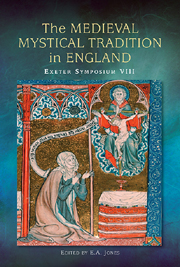 The Medieval Mystical Tradition in England
The Medieval Mystical Tradition in England Book contents
- Frontmatter
- Contents
- Lists of Diagrams and Figures
- List of Contributors
- Abbreviations
- Introduction
- The Colours of Contemplation: Less Light on Julian of Norwich
- Behold Not the Cloud of Experience
- Walter Hilton on the Gift of Interpretation of Scripture
- Numeracy and Number in The Book of Margery Kempe
- Religious Mystical Mothers: Margery Kempe and Caterina Benincasa
- Authority and Exemplarity in Henry Suso and Richard Rolle
- Mortifying the Mind: Asceticism, Mysticism and Oxford, Bodleian Library, MS Douce 114
- The Meditaciones of the Monk of Farne
- Envisioning Reform: A Revelation of Purgatory and Anchoritic Compassioun in the Later Middle Ages
- Walton's Heavenly Boece and the Devout Translation of Transcendence: O Qui Perpetua Pietised
- Reformist Devotional Reading: The Pore Caitif in British Library, MS Harley 2322
- Richard Whytford, The Golden Epistle, and the Mixed Life Audience
- Afterword: Future Prospects
- Index
Numeracy and Number in The Book of Margery Kempe
Published online by Cambridge University Press: 05 July 2013
- Frontmatter
- Contents
- Lists of Diagrams and Figures
- List of Contributors
- Abbreviations
- Introduction
- The Colours of Contemplation: Less Light on Julian of Norwich
- Behold Not the Cloud of Experience
- Walter Hilton on the Gift of Interpretation of Scripture
- Numeracy and Number in The Book of Margery Kempe
- Religious Mystical Mothers: Margery Kempe and Caterina Benincasa
- Authority and Exemplarity in Henry Suso and Richard Rolle
- Mortifying the Mind: Asceticism, Mysticism and Oxford, Bodleian Library, MS Douce 114
- The Meditaciones of the Monk of Farne
- Envisioning Reform: A Revelation of Purgatory and Anchoritic Compassioun in the Later Middle Ages
- Walton's Heavenly Boece and the Devout Translation of Transcendence: O Qui Perpetua Pietised
- Reformist Devotional Reading: The Pore Caitif in British Library, MS Harley 2322
- Richard Whytford, The Golden Epistle, and the Mixed Life Audience
- Afterword: Future Prospects
- Index
Summary
For years we have wondered if Margery Kempe could read – or at least what access to literacy she had. Why have we not wondered the following: How did Kempe count and perform mathematical operations? What did she count, and why? What kind of numeracies did Kempe possess or have access to? How did numbers and mathematical operations shape her experiences?
Numeracy, or what Americans refer to as ‘quantitative literacy’, can be defined as one's ability to understand and apply mathematical operations to everyday tasks, as well as the familiarity with mathematical concepts. Numeracy includes such wide-ranging concepts and applications as the measurement of time, money, space, shape, probability, patterns, quantity, predictions and orders of magnitude. Like literacy, numeracy is a social practice, governed and shaped in great part by gender, social status, occupation, and so on, and can be practised in a number of different settings, including the civil, the professional and the leisurely.
Basic numeracy played an important part in late-medieval spiritual practices. Thomas Lentes has argued that number lay at the root of the ‘arithmetic of salvation’: ‘Religious life was not merely marked by quantification and multiplication; rather, counting appeared as an essential component of the practice of piety’. This obsession with enumeration is often equated with the rise of mercantilism, and a number of Kempe scholars have understood the Book in this context.
- Type
- Chapter
- Information
- The Medieval Mystical Tradition in EnglandPapers Read at Charney Manor, July 2011 [Exeter Symposium 8], pp. 59 - 74Publisher: Boydell & BrewerPrint publication year: 2013


